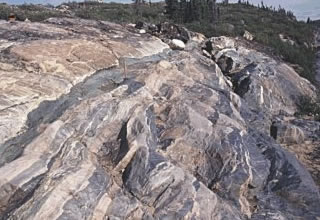Metamorphic Textures
Acasta Gneiss in the Slave Province
The texture of a metamorphic rock is both a description of its constituent minerals along with their arrangement and size. Typically this will be initially described as foliated or non foliated.
Foliated Textures
Foliation is described as the existence or appearance of layers. Foliated textures result from a parallel arrangement of flat, platy minerals. This is usually a result of mineral recrystallization in the presence of a directed pressure. Under this condition, the mineral grains will grow in an orientation that best distributes the force of the pressure. Typically, mineral grains will grow perpendicular to the force being enacted on them.
The larger the crystal size within the metamorphic rock the greater the metamorphic grade. In other words metamorphic rocks with a coarse grained foliated texture have undergone a greater intensity of pressure. This information is useful in determining the conditions under which the rock has formed, which can give valuable insight into its geologic past.
| Foliated Textures | ||
| Slaty | Very flat foliation that resembles mineral cleavage. Develops in clay or mica rich rocks. Indicative of low grade metamorphism. |
 |
| Phyllitic Foliation | Wavy wrinkled foliation made up of small platy minerals such as muscovite and chlorite. Usually gives rock a somewhat metallic, "shiny" look. Indicative of an intermediate grade metamorphism |  |
| Schistocity | Scaly layering of large (visible) crystals of platy minerals such as amphibole, micas, and chlorite. This texture is the product of intermediate to high grade metamorphism |
 |
| Gneissic | Alternating layers of dark and light medium to coarse grained mineral crystals. Indicative of high grade metamorphism |  |
Nonfoliated Textures
Nonfoliated metamorphic rocks do not appear to have any layering although they may contain long thin crystals, such as toumaline and hornblend that do grow perpendicular to the directed force. Non foliated textures have no obvious features and are classified mainly on the basis of crystal size.
Just as foliated metamorphic rocks, nonfoliated metamorphic rocks are produced through recrystallization, neometamorphis and metasomatism.
During recrystallization, small crystals of one mineral in contact with one another slowly come together to form fewer larger crystals. For example, the sedimentary rock, limestone. Limestone is composed of microscopic crystals of calcite that once formed the shells of marine creatures. When metamorphosed, those tiny crystals are slowly forced together under high pressure and begin to form larger, more visible crystals of calcite found in the metamorphic rock marble.
In other situations, the loss or addition of chemicals results in metasomatism. This can best be seen in the production of anthracite coal, which is almost pure carbon. The parent rock bituminous coal is produced from the aggregation of dead plant material, and anthracite is produced by the loss of the more volatile materials such as nitrogen, oxygen, and methane.

